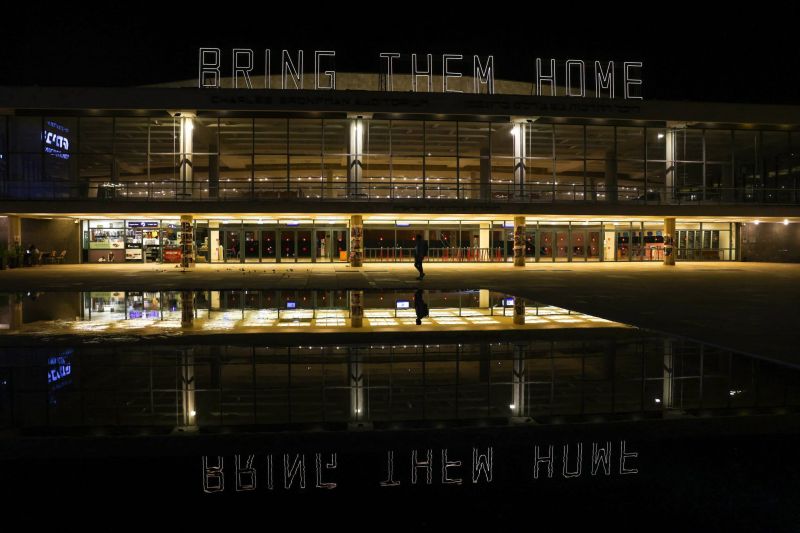
A sign illuminates a square in Tel Aviv calling for the release of Israelis held hostage in the Gaza Strip since the Oct. 7 attack by Hamas militants, on Nov. 21, 2023, amid ongoing battles between Israel and the Palestinian armed group. (Credit: Ahmad Gharabli/AFP)
A discreet "cell," complex communications involving heads of state and heads of several secret services, advances and setbacks, a senior American official described on Tuesday the "terribly trying" process which resulted in an agreement on the release of Hamas hostages.
The Israeli government approved the deal providing for the release of 50 hostages in exchange for the release of Palestinian prisoners and a four-day truce in the Gaza Strip.
To get there, it took five weeks of “terribly trying” negotiations, said this official, who did not wish to be named, in an interview with the press on Tuesday evening.
Very quickly after the bloody and unprecedented attack on Oct. 7 by Hamas on Israeli soil, Qatar, according to him, offered to mediate for a possible release of the hostages taken to the Gaza Strip by the Palestinian Islamist group – around 240 people.
Cell
A “cell” was then established to “work very carefully, very discreetly.” The Biden administration was represented by two senior White House officials, Brett McGurk and Josh Geltzer.
What followed, for weeks, were “daily contacts, sometimes hour by hour” between Americans, Israelis, Qataris and Egyptians.
Egypt, which holds the only opening to the world in the Gaza Strip which is not in the hands of Israel, the Rafah crossing, is a historic and essential mediator in the Israeli-Palestinian conflict.
Qatar, for its part, welcomes the exiled leader of Hamas but also maintains good relations with Washington.
A first important step was taken on Oct. 20 with the release of two American women detained by Hamas, "a life-size test," reported the senior American official, indicating that the White House had, that day, followed their path towards freedom “in real-time.”
Mossad and CIA
Their release "gave us confidence" in the procedure then established, by confirming Qatar's key role.
The head of the Israeli Mossad, David Barnea, and the head of the American CIA, Bill Burns, joined the restricted circle of discussions at this time.
American President Joe Biden was holding more meetings with Israeli Prime Minister Benjamin Netanyahu.
The discussions, "very detailed and technical," quickly came up against a crucial question: the identification by Hamas of the hostages it could release.
Communications are "difficult" and laborious, "messages must go through Doha and Cairo to the Gaza Strip, and return in the other direction," again according to the same source.
50 names
At the end of October and the beginning of November, the agreement "begins to take shape," there is already talk of releasing 50 people but Hamas, according to the senior American official, only provides a list of 10 names.
On Nov. 12, Joe Biden picked up his phone and informed the Emir of Qatar, Sheikh Tamim bin Hamad Al-Thani, that we must go further.
Hamas, again according to this senior White House official, ended up producing 50 names of women and children, with identification criteria.
On Nov. 14, Israel gave the first green light.
That day, "we were approaching the conclusion when suddenly everything stopped," Hamas stopped responding, continued the source.
5 to six names
When contact was re-established, the Palestinian Islamist group, on several occasions, “interrupted the discussions.”
On Nov. 17, the American president was in San Francisco (California) for a summit with countries around the Pacific Rim when he received another phone call, this time to agree with the Emir of Qatar that it was time to “seal” the agreement .
On Nov. 18, the American envoy Brett McGurk, joined by the CIA boss by teleconference, participated in a decisive meeting in Doha, resulting in a "five to six page" plan, which detailed the release process so that “nothing is left to chance."
The next day, during an interview with the head of the Egyptian intelligence services, Abbas Kamel, a response from Hamas made it possible to resolve certain outstanding points.
So, “for the first time,” the Americans “see the agreement taking shape.”
Tuesday evening (US time), Joe Biden said in a statement that he was “extraordinarily satisfied” with the imminent release of the hostages.